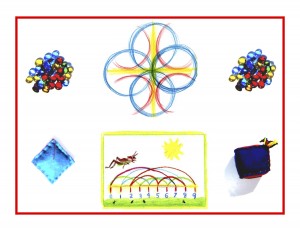Day 88
For one year, 365 days, this blog will address the Common Core Standards from the perspective of creating an alternate, ambient learning environment for math. Ambient is defined as “existing or present on all sides, an all-encompassing atmosphere.” And ambient music is defined as: “Quiet and relaxing with melodies that repeat many times.”
Why ambient? A math teaching style that’s whole and all encompassing, with themes that repeat many times through the years, is most likely to be effective and successful. Now that a foundation has been built, so numbers are known in a deeper way than mere rote recognition, an affinity for the subject can begin to take root.
The dictionary defines affinity as: empathy for, rapport with, sympathy for, accord with, harmony with, relationship with, bond with, fellow feeling for, closeness with/to, understanding of/for, fondness of/for. ANTONYMS aversion, dislike. The first half of the Grade 1 year must be devoted to building a love of math, thus avoiding an aversion to or dislike for it.
Now that a foundation has been built, and all 4 processes have been introduced, it is time for the numbers to come together in calculation. We can now revisit the Common Core Grade 1 Math Standards, beginning with the Grade 1 overview, listed below in blue and followed by ambient alternatives.
CCSS Grade 1 Overview
Operations and Algebraic Thinking
Represent and solve problems involving addition and subtraction.
Understand and apply properties of operations and the relationship between addition and subtraction.
Add and subtract within 20.
Work with addition and subtraction equations.
As stated above, all 4 processes should be worked with at once. It’s possible to see their natural relationships early on, and since multiplication and division are not intrinsically more difficult than addition and subtraction if kept to single digits under 20, this is absolutely doable. Common Core proponents speak of the necessity to work in depth, but it seems their intent is to promote a deep but abstract understanding of the underlying method, so that math cannot be appreciated in all its layers as profoundly beautiful with yes, even moral implications.
As Albert Einstein said, “It is not enough to teach a man a specialty. Through it he may become a kind of useful machine but not a harmoniously developed personality. It is essential that the student acquire an understanding of and a lively feeling for values. He must acquire a vivid sense of the beautiful and of the morally good. Otherwise he—with his specialized knowledge—more closely resembles a well-trained dog than a harmoniously developed person.”
Number and Operations in Base Ten
Extend the counting sequence.
Understand place value.
Use place value understanding and properties of operations to add and subtract.
Traditionally, in both national and most if not all state standards (pre-Common Core) the requirement has been counting up to 100 for Grade 1, no set requirement for Kindergarten. Place value per se is best saved for mid to late Grade 2. It can be touched on with very experiential, concrete and imaginative activities, but should not be formally taught yet. Properties of operations can be used to add, subtract, multiply, and divide.
Measurement and Data
Measure lengths indirectly and by iterating length units.
Tell and write time.
Represent and interpret data.
Time and measurement should not be taught formally until Grade 3 for reasons cited earlier. Of course there will be informal awareness at first, but abstracting either one too early can be detrimental to optimal, healthy learning. Developmental awareness is key, so that teaching anything when the time is right and ripe is best. A butterfly in its cocoon is an apt analogy. Nothing is gained and the butterfly is lost, if extracted from the cocoon prematurely.
Geometry
Reason with shapes and their attributes.
See this blog, Day 55 for an ambient, form drawing related alternative to this standard.
Knowledge ensues in an environment dedicated to imaginative, creative knowing, where student and teacher alike surrender to the ensuing of that knowledge as a worthy goal. Tune in tomorrow for the eight CCSS Mathematical Practice Standards and their ambient alternatives.












